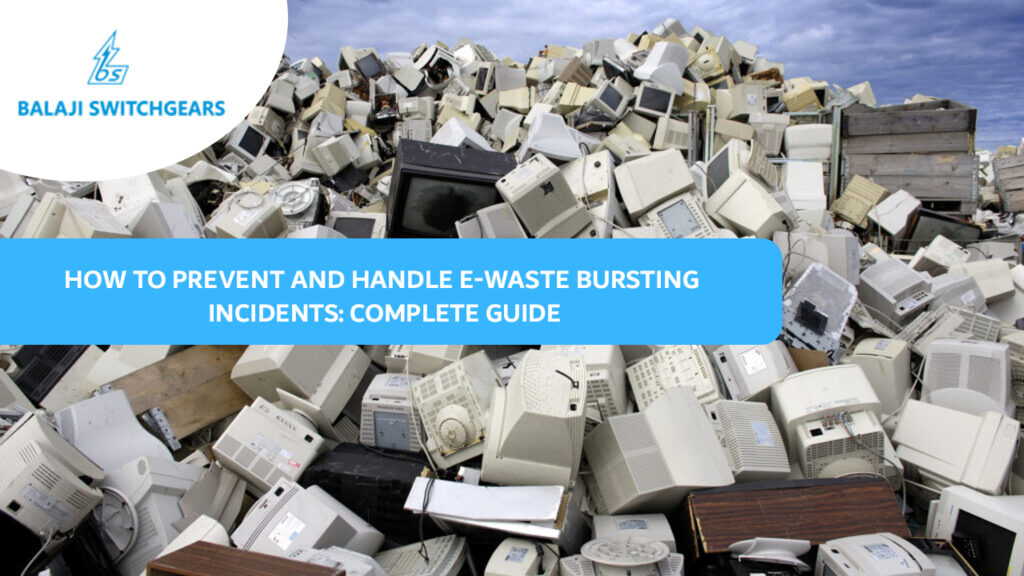Introduction
The digital revolution has transformed the way we live, work, and communicate. However, it has also led to an unprecedented rise in electronic waste (e-waste). As devices become obsolete at an ever-increasing rate, the volume of e-waste generated globally has reached alarming levels. This guide aims to shed light on the critical issue of e-waste bursting incidents, which, while infrequent, can have severe environmental and health repercussions. Through a detailed examination of e-waste and its challenges, this guide offers a roadmap for prevention and management strategies that can safeguard our planet and its inhabitants.
Understanding E-Waste
E-waste refers to discarded electronic appliances and gadgets that are no longer in use. This category includes a vast array of products, from everyday consumer electronics like smartphones and laptops to larger household appliances and industrial equipment. The complexity of these devices means they often contain a mix of valuable materials such as gold, silver, and copper, alongside hazardous substances like lead, mercury, and cadmium. When not properly handled, these materials can pose significant environmental and health risks, particularly in the event of an e-waste bursting incident.
The Dangers of E-Waste
The hazards of e-waste are multifaceted. When electronic devices are improperly disposed of, they can cause physical harm through bursting, leading to fires or explosions. The chemical dangers are equally concerning; toxic substances can leach into the soil and groundwater, contaminating ecosystems and entering the food chain. The health implications for humans are dire, with potential exposure leading to chronic diseases and developmental disorders. The environmental impact is also profound, as e-waste contributes to the degradation of natural habitats and the loss of biodiversity.

Prevention Strategies
1. Consumer Education: The cornerstone of e-waste prevention is consumer awareness. By understanding the impact of their electronic purchases and disposals, individuals can make informed decisions that contribute to the reduction of e-waste. Educational initiatives should focus on the lifecycle of electronic products and the importance of recycling and proper disposal.
2. Design for Environment (DfE): Manufacturers have a responsibility to minimize the environmental footprint of their products. By adopting DfE principles, companies can create electronics that are easier to recycle, repair, and upgrade, thereby extending their useful life and reducing the likelihood of e-waste incidents.
3. Governmental Regulations: Effective e-waste management requires robust legislation and enforcement. Governments must establish and uphold regulations that mandate responsible e-waste disposal and promote recycling. Policies such as Extended Producer Responsibility (EPR) can drive manufacturers to take a more active role in the post-consumer phase of their products.
Advanced Recycling Techniques
1. Automated Sorting Systems: The integration of advanced technologies like AI and robotics can revolutionize the e-waste recycling industry. Automated systems can accurately sort materials, reducing human exposure to hazardous substances and increasing the efficiency of the recycling process.
2. Hydrometallurgical Methods: These methods offer a cleaner alternative to traditional smelting processes. By using chemical solutions to dissolve and recover precious metals, hydrometallurgical techniques reduce environmental pollution and energy consumption.
3. Biological Recovery: The use of microorganisms in bioleaching presents a sustainable method for metal recovery. This biological approach is less energy-intensive and has a lower environmental impact compared to conventional methods.

Case Studies
1. Urban Mining in Cambridge: The city of Cambridge has pioneered an urban mining program that serves as a model for e-waste management. By prioritizing the collection and recycling of e-waste, the city has significantly reduced landfill waste and created a blueprint for others to follow.
2. E-Tadweer in Egypt: The innovative E-Tadweer app demonstrates how technology can incentivize recycling. By rewarding users for responsible e-waste disposal, the app promotes a circular economy and encourages sustainable behavior.
3. India’s E-Waste Revolution: India’s approach to e-waste management showcases the potential of developing economies to lead in this area. Through the establishment of specialized recycling facilities and public awareness campaigns, India is tackling the e-waste challenge head-on.
Conclusion
The journey towards effective e-waste management is complex and requires a multi-faceted approach. By combining consumer education, sustainable product design, stringent regulations, and advanced recycling techniques, we can address the e-waste challenge. This comprehensive guide serves as a call to action for all stakeholders to play their part in creating a sustainable and safe technological future.


I loved as much as youll receive carried out right here The sketch is tasteful your authored material stylish nonetheless you command get bought an nervousness over that you wish be delivering the following unwell unquestionably come more formerly again since exactly the same nearly a lot often inside case you shield this hike
Magnificent beat I would like to apprentice while you amend your site how can i subscribe for a blog web site The account helped me a acceptable deal I had been a little bit acquainted of this your broadcast offered bright clear idea
Just wish to say your article is as surprising The clearness in your post is just cool and i could assume youre an expert on this subject Fine with your permission allow me to grab your RSS feed to keep updated with forthcoming post Thanks a million and please keep up the enjoyable work